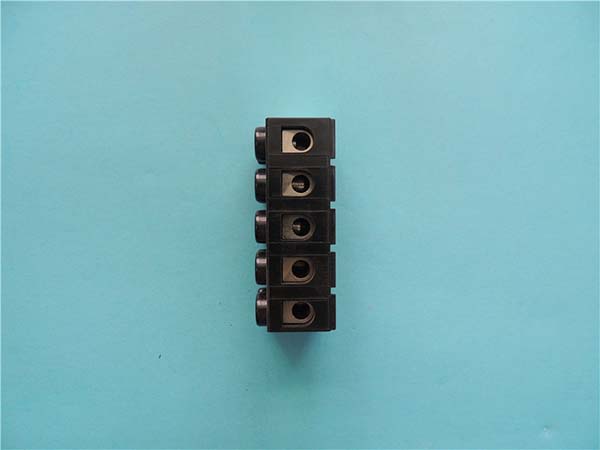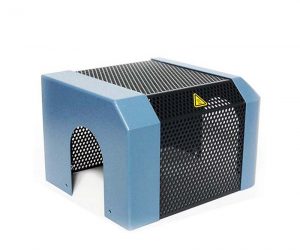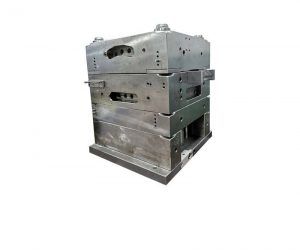What is Bakelite Phenolic?
Definition and Chemical Structure
Baquelite phenolic, commonly known as bakelite, is a type of thermosetting plastic derived from the reaction between phenol and formaldehyde. The chemical structure of phenolic resin is formed through a condensation polymerization process. When phenol and formaldehyde react under the influence of a catalyst (either acidic or basic), they form a three - dimensional cross - linked polymer structure.
The reaction can be described by the following general equation: \(nC_6H_5OH + nHCHO \xrightarrow[]{Catalyst} [-C_7H_6O-]_n + nH_2O\). In this reaction, the hydroxyl group (\(-OH\)) of phenol and the aldehyde group (\(-CHO\)) of formaldehyde combine, eliminating water molecules and creating a long - chain polymer.
There are two main types of phenolic resins: thermoplastic and thermosetting. Thermoplastic phenolic resins, also known as novolacs, are linear polymers formed when there is an excess of phenol in the reaction. They can be melted and reshaped upon heating, as they do not have a fully cross - linked structure. For Yigu Technology example, in some electrical components that require easy formability during manufacturing, thermoplastic phenolic resins might be used in the initial stages of production.
Properties of Bakelite Phenolic
Understanding the properties of bakelite phenolic is crucial for determining its suitability in various applications. Its unique combination of mechanical, thermal, chemical, and electrical properties makes it a versatile material in many industries.
Mechanical Properties
Bakelite phenolic exhibits several notable mechanical properties. It has a relatively high hardness, which contributes to its durability in applications where surface wear is a concern. For example, in some industrial equipment components that are in constant contact with other parts, the hardness of bakelite phenolic helps to resist abrasion. On a scale of 1 - 10 (where 10 is the hardest, like diamond), bakelite phenolic typically has a hardness of around 3 - 4, which is harder than many common plastics.
In terms of strength, bakelite phenolic has a tensile strength that can range from 30 - 50 MPa (megapascals). This strength allows it to withstand moderate pulling forces without breaking. To put this into perspective, the following table compares the tensile strength of bakelite phenolic with some other common materials:
| Material | Tensile Strength (MPa) |
| Bakelite Phenolic | 30 - 50 |
| Polyethylene (HDPE) | 22 - 30 |
| Aluminum Alloy 6061 | 200 - 300 |
| Mild Aço | 300 - 500 |
As shown in the Yigu Technology table, while bakelite phenolic is not as strong as metals like aluminum alloy or mild steel, it has a higher tensile strength than some common plastics such as high - density polyethylene (HDPE).
Bakelite phenolic also has good wear resistance. When used in applications like gears or bearings in low - to - medium load mechanical systems, it can maintain its shape and integrity over time. The cross - linked structure of bakelite phenolic contributes to its wear - resistant property, as the strong chemical bonds between the polymer chains are not easily broken by frictional forces.
Thermal Properties
One of the most significant thermal properties of bakelite phenolic is its high heat resistance. General - purpose bakelite phenolic can withstand temperatures up to 150 - 180°C continuously without significant degradation of its mechanical and chemical properties. Some specialized formulations can even endure temperatures as high as 300°C for short periods.
For example, in the automotive industry, bakelite phenolic is used in engine components such as distributor caps and ignition parts. These parts are exposed to high temperatures generated by the engine, and bakelite phenolic's heat resistance ensures their reliable operation. In the aerospace industry, it may be used in certain non - critical heat - resistant components in aircraft engines or in the interior of the aircraft where there is a need for materials that can withstand high - temperature fluctuations during flight.
Bakelite phenolic also has good thermal stability. It does not undergo significant dimensional changes with temperature variations within its operating range. This property is crucial in applications where precise dimensions are required, such as in the manufacturing of electrical connectors or precision - molded parts for electronic devices. The coefficient of thermal expansion of bakelite phenolic is relatively low, typically in the range of \(10 - 30\times10^{-6}/°C\). In comparison, some plastics like polyethylene have a much higher coefficient of thermal expansion, around \(100 - 200\times10^{-6}/°C\), which means they expand and contract more significantly with temperature changes.
Chemical Resistance
Bakelite phenolic shows excellent resistance to a wide range of chemicals. It is highly resistant to acids, such as dilute sulfuric acid (\(H_2SO_4\)) and hydrochloric acid (\(HCl\)), and can withstand their corrosive effects without significant damage. For instance, in chemical processing plants where these acids are used, bakelite phenolic can be used to make pipes, valves, or storage containers for handling these acidic substances.
It is also resistant to many organic solvents, including alcohols (e.g., ethanol, \(C_2H_5OH\)) and hydrocarbons (e.g., toluene, \(C_7H_8\)). This resistance to organic solvents makes it suitable for applications in the paint and coating industry, where it can be used in components that come into contact with solvent - based paints or cleaning agents.
The chemical resistance of bakelite phenolic is due to its cross - linked polymer structure. The strong covalent bonds in the cross - links are not easily attacked by chemical reagents, providing a barrier against chemical corrosion. When compared to some other plastics, such as polyethylene, which is relatively easily attacked by certain chemicals, bakelite phenolic offers superior chemical resistance. Polyethylene can be softened or even dissolved by some strong solvents, while bakelite phenolic remains stable under the same conditions.
Electrical Properties
Bakelite phenolic is well - known for its outstanding electrical properties, especially its excellent electrical insulation. It has a very high volume resistivity, typically in the range of \(10^{12}-10^{14}\ \Omega\cdot m\) (ohm - meters). This high resistivity means that it is an extremely poor conductor of electricity, making it ideal for use in electrical insulators. For example, in high - voltage electrical transformers, bakelite phenolic is used to insulate the electrical windings, preventing the leakage of current and ensuring the safe and efficient operation of the transformer.
The dielectric constant of bakelite phenolic is relatively low, usually around 4 - 6 at room temperature and at a frequency of 1 MHz. A low dielectric constant is beneficial in electrical applications as it means that the material stores less electrical energy in an electric field. This property is important in applications such as printed circuit boards (PCBs), where a low - dielectric - constant material can help to reduce signal attenuation and improve the performance of high - speed electronic circuits. In comparison, some other materials like ceramics may have a much higher dielectric constant, which can be a disadvantage in certain high - frequency electrical applications.
Applications of Bakelite Phenolic
The unique properties of bakelite phenolic make it a material of choice in a wide range of industries. Its applications span from everyday consumer products to high - tech industrial components.
In the Electrical and Electronic Industry
In the electrical and electronic industry, bakelite phenolic is widely used due to its excellent electrical insulation properties. For example, it is commonly used in the production of electrical sockets and switches. The high volume resistivity of bakelite phenolic, typically in the range of \(10^{12}-10^{14}\ \Omega\cdot m\), ensures that these components can safely insulate against electrical current, preventing electric shocks and short - circuits. In a standard household electrical socket, bakelite phenolic provides a reliable and durable insulating material for the electrical contacts, withstanding the normal wear and tear from frequent plugging and unplugging of electrical appliances.
Printed circuit boards (PCBs) also often incorporate bakelite phenolic. The low dielectric constant of bakelite phenolic, around 4 - 6 at room temperature and at a frequency of 1 MHz, is beneficial in reducing signal attenuation in high - speed electronic circuits. This property allows for better performance of electronic devices such as smartphones, computers, and tablets. In some high - performance PCBs, the use of bakelite phenolic - based materials can contribute to faster data transfer rates and more stable electrical connections.
Electrical insulators for high - voltage applications are another area where bakelite phenolic is crucial. In power transmission systems, insulators made of bakelite phenolic are used to separate and support high - voltage conductors. These insulators need to withstand high electrical stress, and bakelite phenolic's excellent electrical insulation and mechanical strength make it suitable for this demanding application.
In the Automotive Industry
The automotive industry makes use of bakelite phenolic in several components. Brake pads are one of the most common applications. Bakelite phenolic, when combined with other materials such as fibers (e.g., asbestos - in the past, but now often replaced with other non - asbestos fibers like aramid), forms a composite material with excellent friction and wear - resistance properties. When a vehicle brakes, the brake pads come into contact with the brake rotors, and the friction generated slows down the wheels. Bakelite phenolic - based brake pads can maintain a consistent coefficient of friction over a wide range of temperatures, ensuring reliable braking performance. For example, during high - speed braking or repeated braking maneuvers, the heat - resistance of bakelite phenolic helps prevent the brake pads from overheating and losing their effectiveness.
Clutch discs also often contain bakelite phenolic. In a manual transmission vehicle, the clutch disc is responsible for transferring torque from the engine to the transmission. Bakelite phenolic's high - temperature resistance and mechanical strength enable it to withstand the high - pressure and high - temperature conditions during clutch engagement and disengagement. This ensures smooth operation of the clutch system and contributes to the overall reliability and longevity of the transmission.
Some interior components of cars, such as knobs and handles, are made of bakelite phenolic. Its hardness and durability make it suitable for these applications, as they are frequently touched and used by the driver and passengers. Additionally, bakelite phenolic can be easily molded into various shapes, allowing for aesthetically pleasing designs.
In the Aerospace Industry
In the aerospace industry, bakelite phenolic finds applications in both aircraft interiors and engine components. In aircraft interiors, it is used for items like overhead storage bins, seat components, and interior panels. The material's light weight, combined with its fire - resistance properties, makes it an ideal choice. In the event of a fire on an aircraft, materials in the interior need to be fire - resistant to slow down the spread of the fire and give passengers and crew more time to evacuate. Bakelite phenolic has good fire - retardant characteristics, and its combustion products produce relatively low smoke, which is crucial for maintaining visibility in an emergency situation.
For engine components, bakelite phenolic can be used in non - critical parts that require heat resistance. Although aerospace engines operate at extremely high temperatures, some components, such as certain casings or brackets, can be made of bakelite phenolic due to its ability to withstand temperatures up to 150 - 180°C continuously and even higher temperatures for short periods. Its heat - resistance and dimensional stability help ensure the proper functioning of these components in the high - temperature environment of the engine.
Processing and Fabrication Tips
Injeção de moldes
When processing bakelite phenolic through injection molding, precise temperature control is essential. The ideal temperature for the barrel of the injection molding machine is usually in the range of 70 - 90°C for the pre - plasticization stage. For Yigu Technology example, if the barrel temperature is set too high, say above 100°C, the bakelite phenolic may start to cure prematurely in the barrel, leading to blockages in the injection system. The injection pressure also needs to be carefully adjusted. Since bakelite phenolic has a relatively high viscosity due to its cross - linked structure and the presence of fillers (such as sawdust in some formulations), a higher injection pressure is often required compared to processing some other plastics. A pressure in the range of 80 - 150 MPa may be necessary, depending on the complexity of the mold and the thickness of the part.
Compression Molding
In compression molding, the mold temperature is a critical parameter. For bakelite phenolic, the mold temperature is typically set between 150 - 180°C. At this temperature range, the bakelite phenolic resin can flow and fill the mold cavity properly during the compression process. The curing time also depends on the thickness of the part. Thicker parts may require longer curing times, usually ranging from a few minutes to tens of minutes. For instance, a 5 - mm - thick bakelite phenolic part may need a curing time of about 5 - 10 minutes, while a 10 - mm - thick part could require 15 - 20 minutes. Applying sufficient pressure during compression molding is also important. A pressure of around 10 - 30 MPa is commonly used to ensure the part has good density and mechanical properties.
Machining
When machining bakelite phenolic, using sharp cutting tools is crucial. High - speed steel or carbide - tipped tools are often preferred. The cutting speed should be adjusted according to the type of machining operation. For Yigu Technology example, during milling, a cutting speed of 50 - 100 m/min may be suitable, while for drilling, a lower speed of 20 - 50 m/min may be more appropriate. Lubrication is also important to reduce heat generation and tool wear. A water - soluble cutting fluid can be used to cool the cutting area and flush away the chips. However, care must be taken to ensure that the cutting fluid does not cause any chemical reactions with the bakelite phenolic.
Maintenance and Precautions
When using and maintaining bakelite phenolic products, several precautions should be taken. Avoid subjecting bakelite phenolic parts to excessive mechanical stress. Although it has good mechanical strength, overloading can cause cracking or deformation. For example, in an electrical switch made of bakelite phenolic, do not use excessive force when operating the switch, as this could damage the bakelite phenolic housing.
Prevent chemical erosion. While bakelite phenolic is resistant to many chemicals, it can be attacked by strong oxidizing agents or concentrated acids and bases. In a chemical processing plant, if bakelite phenolic components are in contact with chemicals, make sure they are compatible. If there is a risk of chemical exposure, protective coatings can be applied to the bakelite phenolic surface.
For products used in high - temperature environments, monitor the temperature regularly. Prolonged exposure to temperatures above the recommended limit can degrade the material's properties. In an industrial oven where bakelite phenolic components are used, install temperature sensors to ensure the operating temperature stays within the safe range of 150 - 180°C for general - purpose bakelite phenolic.
In applications where electrical insulation is critical, regularly check for any signs of damage or degradation that could affect the electrical properties. In an electrical transformer, inspect the bakelite phenolic insulators periodically for cracks or signs of charring, as these could lead to electrical failures.
Conclusion
In Yigu Technology conclusion, bakelite phenolic is a remarkable material with a rich history and a wide range of applications. Its unique properties, including high heat resistance, excellent electrical insulation, good chemical resistance, and decent mechanical strength, make it a valuable choice in many industries.
Bakelite phenolic has a high - temperature resistance that allows it to withstand temperatures up to 150 - 180°C continuously for general - purpose grades, and even higher temperatures for short periods in specialized formulations. Its high volume resistivity, in the range of \(10^{12}-10^{14}\ \Omega\cdot m\), ensures reliable electrical insulation, making it essential in electrical and electronic applications. The material's good chemical resistance to acids, bases, and organic solvents expands its usability in chemical - processing and other industries where exposure to various chemicals is common.
In the electrical and electronic industry, bakelite phenolic is used in electrical sockets, switches, printed circuit boards, and high - voltage insulators. In the automotive industry, it is applied in brake pads, clutch discs, and interior components. In the aerospace industry, it finds use in aircraft interiors and non - critical engine components. It also has applications in the construction, furniture, and consumer goods industries.


